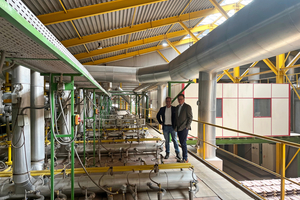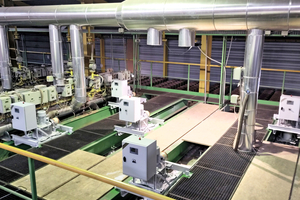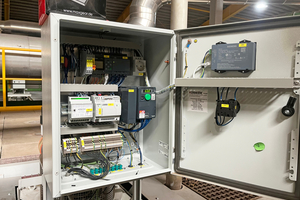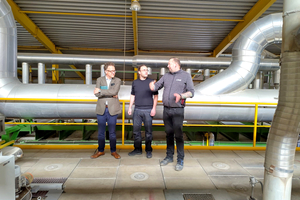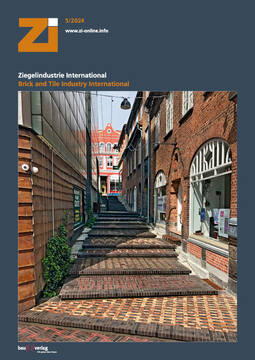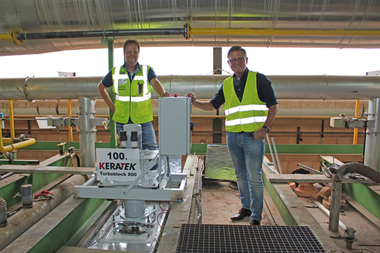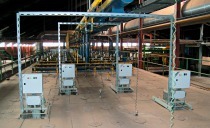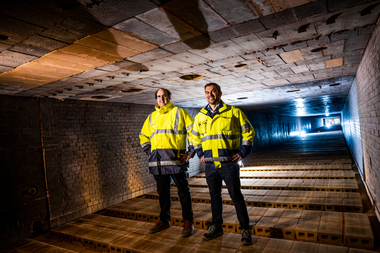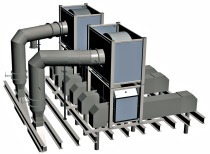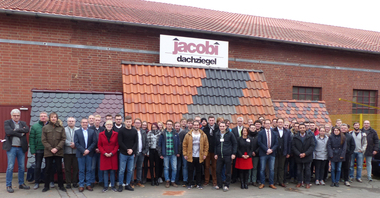Keratek causes circulations at Jacobi-Walther Dachziegel
The family business Jacobi-Walther Dachziegel has been in existence for around 160 years. With the 200th anniversary as the focal point of the company‘s activities, measures are constantly being taken to improve production efficiency. As one of the most energy and CO2-intensive systems, the tunnel kiln is an important starting point. However, a tunnel kiln reacts to any change. Conversions and retrofits are therefore anything but trivial, especially when it comes to roof ceramics. This is why Dominic Jung, Managing Director of Jacobi-Walther Dachziegel, Martin John, senior employee, and Christian Gäbelein, Managing Director of Keratek, see the smooth installation and operation of 15 Turboblock 800 circulators in three tunnel kilns at the Bilshausen plant as a great success.
Family business with over 160 years of history
Jacobi Tonwerke GmbH is a family-run company now in its sixth generation. Founded in 1860 by Joseph Jacobi in Duderstadt, a second site was established in Bilshausen in 1919, which has been the main site since 1946. Located on the former inner-German border, the construction boom after reunification led to a massive expansion of production capacity. Between 1992 and 2000, the company invested into four new plants and annual output increased from fifteen million to fifty million pressed roof tiles. In 2005, the brickworks company Walther, founded in Langenzenn in 1878, was acquired. According to its own information, Jacobi Tonwerke is one of the largest medium-sized companies in the German roof tile industry with a market share of around ten per cent. Today, a total of 440 employees exclusively manufacture roof tiles.
Vision „200 years of Jacobi Walther roof tiles“
Dominic Jung describes the company‘s overarching goal as the vision of „200 years of Jacobi Walther roof tiles“. As a family business, the company looks to continuity in business operations and reliable prospects for the future. This inevitably includes completely decarbonising the company by the anniversary. To drive this process forward, the company is working on gradual improvements to its operating processes and facilities, such as reducing environmentally harmful emissions, energy consumption and costs.
Dominic Jung cites the combined heat and power plant that was commissioned in 2016 as one example of this, which covers part of the plant‘s electricity requirements independently. A second example is a recently applied internal kiln coating, which reflects some of the heat flowing out through the kiln walls into the kiln interior.
A central component of constant operational optimisation, emphasises Dominic Jung, is the most efficient and detailed digital monitoring of processes and consumption. The digitalisation of operating and consumption data recording and evaluation has been underway at the Bilshausen and Langenzenn sites for almost ten years. In 2015, the first gas and electricity meters were equipped with network-compatible data loggers so that consumption could be read automatically and the values recorded centrally. Martin John reports that around 40 loggers have now been installed. More are installed wherever renovations or new builds take place. The master ceramist with a passion for microelectronics has been instrumental in driving forward the digitalisation of data recording. Today, 99 per cent of gas consumption is recorded every quarter of an hour. Electricity meters are not quite as advanced yet.
In addition to the meter network, a system network has also been installed to monitor the performance of the operating systems and optimise maintenance and replacement. The gradual and, as far as possible, gradual connection of the systems is still ongoing. This is not always easy, emphasises Martin John, because the systems are very heterogeneous: there is everything from original pieces from the 1930s to modern digitalised systems.
A networked press at one kiln automatically provides operating values such as pressings per minute and power consumption. This data can be read out centrally via a dashboard. The combined heat and power plant is also already networked and starts up automatically depending on the amount of grid power used. According to Martin John, monitoring with detailed recording has proved particularly useful in recent times with fluctuating production volumes and capacity utilisation in order to detect irregularities and consumption peaks.
Decision in favour of circulators from Keratek
As part of the expansion of data acquisition and data-supported operational optimisation, Dominic Jung had often thought about installing circulators in the kilns. He was familiar with these devices from a previous job at a backing brick plant, where he had them installed in the kiln. Among other things, the circulators installed there ensured an improvement in quality. The circulation also acts as a virtual kiln extension.
However, he hesitated for a long time to install circulators in a ceramic roof kiln. At the time, there was hardly any experience of the effects these devices could have on the stove and the roof tile product. Finally, he also had doubts as to whether the materials available at the time could withstand the process temperatures.
Keratek GmbH’s expertise in installing the circulators and the properties of the Turboblock 800 tipped the scales in favour of finally installing them. The compact appliances could be integrated into the kiln ceiling with little effort.
The Jacobi-Walter team discussed this step in detail in advance, both internally and with Christian Gäbelein and Wolf Reschke from Keratek, on the basis of operating data and kiln and dryer curves. Dominic Jung calls such processes „always a struggle for a good solution“. The Managing Director of Jacobi Tonwerke of Jacobi-Walther Dachziegel emphasises that it is very helpful when the sparring partners come from outside, are not blind to the company and have gained extensive experience in different companies with different systems.
Christian Gäbelein adds that he analytically discusses the best starting point for optimisation with all customers on the basis of detailed measurements, either carried out by the customer or by Keratek. The guiding question, says Gäbelein, is always: „Where do we have the greatest possible effect?“ This varies from plant to plant and from kiln to kiln. An exact prediction of the efficiency gain can therefore never be made, he emphasises. Another important aspect of this consideration that is often overlooked is aftercare, i.e. subsequent measurements and adjustments.
Risks of installing the circulators
Even for the Keratek managing director, it was not possible to fully predict how the ceramic roof stove would react to the use of the circulators. There was also a lack of experience as to whether and how the impellers of the circulators would react to the special atmosphere of a kiln in which engobes and glazes are fired. This is because the glazes evaporate and can condense on colder surfaces and solidify again. This could result in unwanted and uncontrolled coatings on the blades. As a result, imbalances can occur that increase energy consumption and wear.
It is precisely because of such imponderables, emphasises Christian Gäbelein that risk assessment always plays a special role in advance. In a complex system, you have to be prepared for effects that were not expected. For him, this is also part of the appeal of working with Keratek: „It‘s not a boring business.
As a result of the risk analysis, the decision was made to order and install five circulators for each of the three main furnaces in Bilshausen.
Project planning began in 2019, Dominic Jung recalls, and implementation took place in 2022.
Installation of the circulators
The installation went largely without a hitch. Martin John reports that five circulators have now been integrated into each of the three main kilns in the heating area in the higher temperature range, between 600 and 800 degrees Celsius. The circulators have made some of the burners superfluous. Thanks to digital data acquisition, it was possible to see that many firing zones were only running at half load. This meant that a lot of air had to be heated up. For this reason, around half of the 14 to 15 burners per firing zone and a total of around 180 burners on the kiln were removed. The remaining half of the burners now run under a higher load for an overall better and more efficient combustion air ratio.
Another advantage of the circulators, emphasises Martin John, is that they collect hot air from the main combustion zone, which flows under the kiln roof, and feed it back into the setting. The circulators also reduce the excess air required by the HG burners to be heated up, thus saving energy.
According to Dominic Jung, the results could also be precisely verified with the data from the loggers: “The savings are in the tangible double-digit percentage range”.
It also became clear relatively quickly that glaze kilns and their special atmosphere do not pose a problem for the fans.
Customisation tests on the kiln
One of the biggest challenges after installation was familiarising with the changed combustion unit. This is because any change to the energy or air flows in a tunnel kiln influences the existing control schemes, explains Dominic Jung. The kiln operators have to find out the new parameters by testing them. This is particularly important for roof tiles, as the product should leave the kiln with the same colour and shrinkage as before the modification.
As is always the case at Jacobi-Walther, testing whether the changes to the kiln have an effect on the quality of the product was carried out iteratively. In the first test, the values were changed for two hours and the effects on the product were tested. If successful, the test intervals were extended up to several days. Dominic Jung emphasises that due to this approach, a relevant change to the operation of the kiln may well take several weeks to six months until the effects are satisfactory.
Although this approach is lengthy, there is almost no alternative in view of the costs involved, Christian Gäbelein points out. After all, the value of the goods in the kiln is considerable and roof tiles are a product with little to no tolerance in terms of their properties. If changes to the kiln result in cooling cracks, colour deviations between tiles or colour differences between the top and bottom of the tile, the product is difficult, if not impossible, to sell.
Assessment and outlook
Dominic Jung summarises that the use of the circulators has exceeded expectations. Especially in view of the sensitivity of the product, which requires consistency in all dimensions. The next step, adds Martin John, is towards optimised monitoring. Vibration sensors are being retrofitted to the fans in one kiln in order to automatically monitor the bearings and other mechanical parts and provide a timely warning in the event of a defect. If the system proves successful, he wants to transfer it to all the tunnel kilns.
Dominic Jung is also satisfied with the results of the gradual optimisations. From 2016 to June 2024, it was possible to reduce gas consumption by a good quarter and improve the efficiency of gas-consuming processes by a good quarter. The next step is already planned, namely to record all volume and energy flows to the kiln online.
Gäbelein is also satisfied with the project. He comments on the efficiency gains with a wink: “So far, no customer has used more than before. Most customers are also coming back.” When asked about other projects, he replies that, in addition to optimising operations for customers, he is currently also pursuing his own project. He is looking for an engineer or technician for Keratek who can support him in his work in the long term and take on responsibility.

